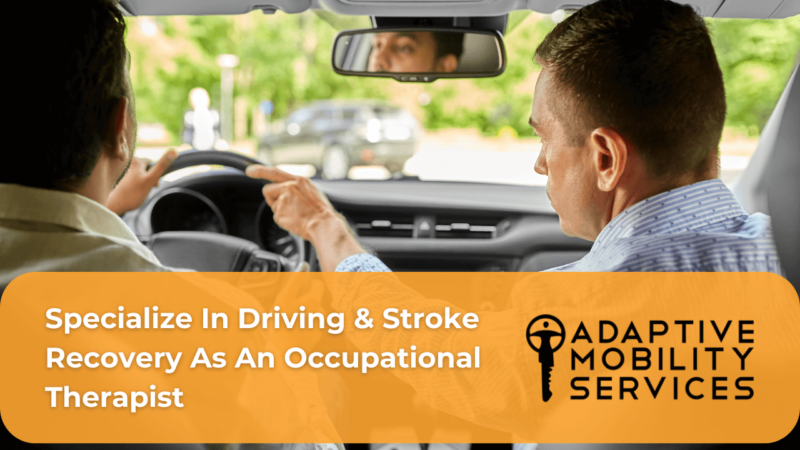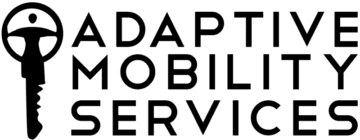
Specialize In Driving & Stroke As An Occupational Therapist
OTs are particularly suited to assist stroke patients regain their confidence and independence behind the wheel are occupational therapists focused on driver rehabilitation. To navigate the results a stroke has on driving ability, OT driver rehabilitation specialists need a combination of professional knowledge, empathy, and ingenuity. From evaluating physical restrictions to correcting cognitive and visual challenges, occupational therapists (OTs) are essential in recovering mobility and autonomy for stroke patients.
Become A Driver Rehabilitation Specialist OT For Stroke Patients
Adaptive Mobility helps occupational therapists serve stroke patients with driver rehabilitation services. We want to empower you and help you get the best results for clients that suffered from a stroke and their families. Learn how to become an OT Driver Rehab Specialist.
Understanding How a Stroke Affects Driving
A stroke may produce a broad spectrum of physical, cognitive, and visual problems directly influencing driving capacity. Though individual differences exist, the particular impacts vary as well; typical issues include:
- Motor Function: Hemiparesis or weakness on one side of the body may restrict steering wheel, accelerator, or brake function.
- Coordination and Reaction Time: Delayed reaction times and poor coordination raise the danger of mistakes.
- Vision Changes: Hemianopia which is the loss of vision on one side can appear in some cases. Double vision, or depth perception problems might make traffic conditions or junction navigation challenging.
- Cognitive Impairments: Stroke survivors could have trouble with attention, memory, judgment, or spatial awareness.
Understanding these difficulties allows occupational therapists to develop rehabilitation programs to meet particular requirements.
Complete Driver Evaluation & Assessment for Stroke Survivors
Determining a stroke survivor’s driving ability starts with a comprehensive evaluation. Here is how an OT driver rehabilitation specialist should approach the process.
1. Stroke Patient’s Clinical Assessment
Compile medical history, changes linked to strokes, and progress toward recovery. Talk about client objectives and driving history to help you meet their requirements. Talk to family members to learn about any driving habits or issues.
2. Evaluate A Stroke Patient’s Driving Ability
Seeing a stroke patient’s driving performance in the real world and under control situations is invaluable. Pay close attention to their lane placement, merging, and decision-making at places like intersections. When evaluating a stroke patient, make sure your scoring is objective and make notes on ways where specific driving tactics or adaptive driving equipment can be helpful.
**Remember, you must have the training, liability coverage, specialized equipment, and knowledge of your state’s licensing regulatory to be in a moving vehicle with a patient.**
3. Help Improve A Stroke Survivor’s Driving Ability
Many stroke patients can recover safe driving ability with correct driver rehabilitation therapy. Your job as an OT DRS is to give direction, instruction, and access to resources, bridging the gap between disabilities and driving safety.
4. Provide Adaptive Equipment To Stroke Patients
As an occupational therapist specializing in driver rehab, you know there are a variety of tools that you can use to help your patients drive more effectively:
- Left-Foot Accelerator: Perfect for people with right-side weakness, left-foot accelerators let users use the brake and accelerator with their left foot.
- Spinner Knob: Assists persons with hemiparesis or poor grip strength with one-handed steering using a spinner knob.
- Hand Controls: Instead of the feet, let acceleration and braking go via the hands.
An OT DRS Helps Skill Development In Stroke Survivors
As an OT our value comes from taking our knowledge and experience and sharing it with stroke survivors. We want to emphasize activities meant to increase range of motion, coordination, and response times. Post-stroke trainings in cognitive development may assist with multitasking, focus, and decision-making.
Stroke Survivor Driver Training You Should Provide As An OT
Using practical experience, teach stroke patients the efficient use of adaptive tools. Add more challenging driving situations gradually to develop confidence and skill.
How To Communicate With Families Of Stroke Survivors
Recovering after a stroke is a long road trip for the client as well as for their loved ones. Families frequently make decisions for the person who suffered a stroke. This is why it is good to focus on sympathetic communication. It is also essential to keep the family up to date on their progression through driver rehabilitation so they understand the process leading up to their freedom to drive again.
Guidelines For Communicating With Stroke Survivor Families
- Specify Expectations: Tell them straight forward what is feasible given the stroke patient’s skills and constraints.
- Include The Family in All Planning: Involving family members in conversations about training programs and adaptive tools will significantly benefit the patient, family, and you.
- Provide Tools & Resources: For clients who may not be able to return to driving, providing options and information on local transportation options will be helpful.
When Driving Retirement Is Required For A Stroke Patient
Not every stroke survivor will be able to go back behind the wheel safely. Approaching this challenging issue with professionalism and empathy is very important.
When communicating with the family, it is important to focus on the patient’s safety. Use information from the evaluation to guide your action plan. This will be hard for the stroke survivor and family to hear, but it is important to communicate that it is not a setback but instead where they are on their rehabilitation journey.
Why Occupational Therapists Are Important for Stroke Driver Rehabilitation
OTs specializing in driver rehabilitation provide a unique viewpoint on post-stroke treatment. Combining our occupational therapy and knowledge with adaptive driving solutions and functional analysis helps clients recover their driving freedom in ways that fit their capacity and safety.
Your knowledge of behavior observation, strengths identification, and solution recommendations is priceless. A client with expressive aphasia, for instance, may do badly on verbal cognition exams yet quite well on functional driving skills. Understanding these subtleties allows for honest and unbiased assessments.
Developing Your Skills as an OT in Driver Rehabilitation
Think about the following approaches to help stroke survivors:
- Stay Up To Date on Equipment: Learn about adaptable tools like hand controllers and left-foot accelerators to ensure you can provide customers the best choices.
- Network with Neurologists: Work with medical experts to match rehabilitation programs to the client’s overall objectives for recovery.
- Leverage Peer Support: Use peer support by joining our OT driver rehabilitation specialist network. We focus on sharing ideas and tools for occupational therapy driver rehabilitation.
Driving After a Stroke: Empowering Patients with Occupational Therapy
Driving after a stroke is more than a possibility; it’s a milestone in freedom and rehabilitation. You have the skills and knowledge as an occupational therapist to help stroke survivors navigate this road map.
One drive at a time, you can significantly change the life of stroke survivors by offering thorough evaluations, deliberate interventions, and sympathetic support.
Equipping OTs to Lead Stroke Patients In Driver Rehabilitation
Reach out to Adaptive Mobility Services to learn about our training OT DRS, our resources, and professional development possibilities if you are an occupational therapist hoping to specialize in driver rehabilitation. Working together, we can lead stroke survivors to safely and confidently resume their journey.
Meet Susie!

Susie Touchinsky, OTR/L, SCDCM, CDRS, is an established expert in both occupational therapy and driver rehabilitation. She has been an OT for more than 20 years and brings expertise and a love for helping others in her speeches and trainings.
Learn More With Our OT Driver Rehabilitation Specialist Courses
Try Our Free OT DRS Courses:
- OTs Role With Driving
- GRID: Generalist Resource to Integrate Driving
- Readiness to Drive: IADL Checklist
- FREE 6 Driving Resources for the OT
- 5-Steps Our Clients Use to Start Their Own Highly-Paid OT Driver Rehab Business
- Driving Risk Screening Tools
- BCAT Brief Cognitive Assessment Test System Overview
- BCAT Part 2: CBS 8 & 15-for-Me
Become the best OT Driver Rehabilitation Specialist you can be by being a life long learner.
